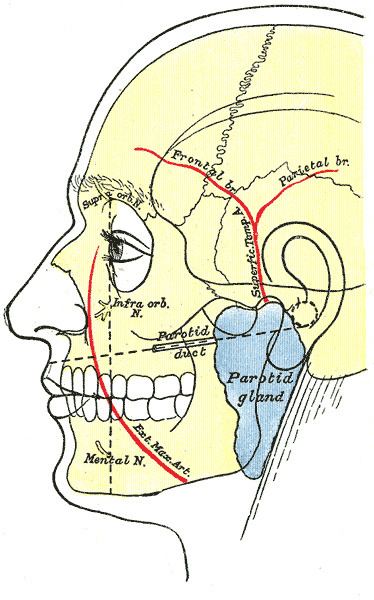Dorlands/Elsevier a_61/12156279 | ||
 | ||
Branches Transverse facial arteryMiddle temporal arteryAnterior auricular branchfrontal branchparietal branch Vein superficial temporal vein Latin arteria temporalis superficialis | ||
In human anatomy, the superficial temporal artery is a major artery of the head. It arises from the external carotid artery when it bifurcates into the superficial temporal artery and maxillary artery.
Contents
Its pulse is palpable superior to the zygomatic arch, anterior and superior to the tragus.
Course
The superficial temporal artery is the smaller of two terminal branches that bifurcate superiorly from the external carotid. Based on its direction, the superficial temporal artery appears to be a continuation of the external carotid.
It begins in the substance of the parotid gland, behind the neck of the mandible, and passes superficially over the posterior root of the zygomatic process of the temporal bone; about 5 cm. above this process it divides into two branches, a frontal and a parietal.
Relations
As it crosses the zygomatic process, it is covered by the Auricularis anterior muscle, and by a dense fascia; it is crossed by the temporal and zygomatic branches of the facial nerve and one or two veins, and is accompanied by the auriculotemporal nerve, which lies immediately behind it.
The superficial temporal artery anastomoses with (among others) the supraorbital artery of the internal carotid artery.
Clinical relevance
The superficial temporal artery is often affected in giant-cell arteritis and biopsied if the diagnosis is suspected.
Migraine attacks can occur when the temporal artery enlarges.
